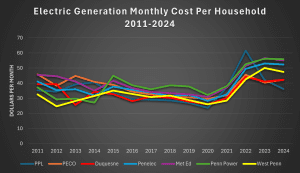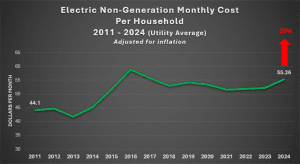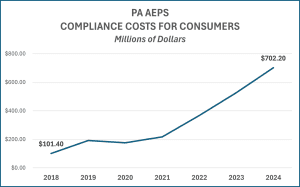<So…What’s Happening with Your Electricity Bill?
September 2nd, 2025
Many people feeling the pinch of their electricity bills are seeking explanations – and solutions – to help blunt the impact on their family budgets.
Before exploring some of the factors influencing electricity prices, some context is important:
- First, the electricity bill you receive represents the total of a host of different charges, from the cost to generate your electricity, to the costs of running transmission and distribution wires to your home, to various taxes and fees. The PA Public Utility Commission provides details on the different components of your bill on their website.
- These costs also include charges for state renewable and alternative energy mandates, as well as capacity charges that ensure there is sufficient generation available to meet anticipated demand.
- And while cost is a major consideration for consumers – so too is the expectation of reliable service. Keeping the infrastructure of our electric grid up to par takes investment, and these investments are reflected in our monthly bills.
Your electricity bill is made up of several different components. Here’s how those costs stack up:
Natural Gas Prices
While natural gas prices have increased moderately year over year, Pennsylvania consumer prices remain among the lowest in the nation. The 2024 average price of natural gas in Pennsylvania was $1.65 per mcf, the second lowest price in the last eight years and – adjusted for inflation – 2024 actually saw the lowest natural gas prices in history.
Cost to Generate Electricity Relatively Stable in PA
Thanks in large part to the increased use of natural gas to generate electricity, Pennsylvanians have enjoyed relatively stable electric generation costs over the past decade – even as outlier factors such as the 2020 pandemic or Russia’s invasion of Ukraine can influence prices in the short term.
The manner in which utilities collect generation costs also influences the impact of your monthly bill. Under state law, utilities can seek to adjust the generation portion of your electric bill every six months. These adjustments at times can appear to be more significant because costs are not gradually added to your bill.
Still, the generation component of monthly electric bills have remained relatively consistent. The following chart shows the electric generation portion of an average residential electricity bill (using 500 kWh/month) for the top seven electric utilities in Pennsylvania from 2011 – 2024:

Source: Pa. PUC
Despite some upticks in recent years (more on that later), the cost to generate electricity has been relatively stable.
However, when the cost to generate electricity is adjusted for inflation, the amount per default residential household has actually gone down since 2011:

Source: Pa. PUC
Non-Generation Costs Continue to Increase
While generation costs have remained stable – in fact, declining by 16% from 2011 to 2024 even after adjusting for inflation – non-generation costs reflected in consumer bills have continued to climb.
Pa. PUC data shows the portion of a customer’s monthly bill tied to costs other than electric generation were up 25% in 2024 compared to costs in 2011. And this is after adjusting for inflation. These include costs tied to distribution, transmission, smart meters, and various taxes and fees, to name a few.

Source: Pa. PUC
Renewable and Alternative Energy Mandates
While generation costs have remained relatively stable over the long haul, state policy decisions also influence the total cost of your electricity bill.
Under the Pennsylvania Alternative Energy Portfolio Standards (AEPS) Act, utilities and competitive electricity suppliers are required to purchase a certain amount of electricity from sources like wind, solar, hydropower and other alternative fuel sources. These sources of energy cost more than traditional baseload electric power, and these costs are passed on to consumers as part of the generation charges in monthly electric bills.
And these costs have skyrocketed – by over 600% – just since 2018:

Source: Pa. PUC
Options to Save
What is a consumer to do?
There are several ways that consumers can save money and reduce their energy costs and consumption. One key way to do so is by shopping for electricity or natural gas through a competitive supplier. Unlike some states, Pennsylvania offers the ability for consumers to choose their electricity and natural gas supplier, locking in rates that may be more favorable than their utility’s default service.
To learn more about competitive suppliers near you, click here to shop for electricity and here to shop for natural gas.
Families may also be eligible for assistance to pay their home energy costs through the LIHEAP Program.
Natural Gas Continues to Keep Generation Rates Affordable
Thanks to the abundance and increased use of natural gas for power generation, wholesale electricity rates have remained stable over the past decade – even decreasing when adjusted for inflation. These consumer savings have helped blunt increases in overall electricity bills tied to distribution, transmission, taxes, fees and state alternative energy mandates.
Natural gas provides a competitive advantage for Pennsylvania and has delivered significant energy cost savings to consumers. Policy choices which encourage competitive markets, remove threats of punitive generation taxes, and help to site and build new in-state power generation are critically important to ensuring that consumer electricity bills are affordable.>
https://marcelluscoalition.org/so-whats-happening-with-your-electricity-bill/ |








